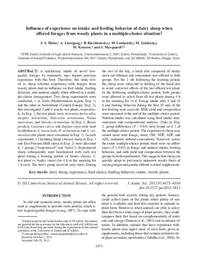Influence of experience on intake and feeding behavior of dairy sheep when offered forages from woody plants in a multiple-choice situation1

Authors:
A satisfactory intake of novel lowquality
forages by ruminants may require previous
experience with this feed. Therefore, this study tested
in sheep whether experience with forages from
woody plants had an influence on feed intake, feeding
behavior, and nutrient supply when offered in a multiple-
choice arrangement. Two sheep experiments were
conducted, 1 in Syria (Mediterranean region; Exp. 1)
and the other in Switzerland (Central Europe; Exp. 2),
that investigated 5 and 6 woody test plants, respectively.
In Exp. 1, the test plants were Artemisia herba-alba,
Atriplex leucoclada, Haloxylon articulatum, Noaea
mucronata, and Salsola vermiculata. In Exp. 2, Betula
pendula, Castanea sativa, and Juglans regia were used
in addition to A. leucoclada, H. articulatum, and S. vermiculata
(the plants most consumed in Exp. 1). In each
experiment, 12 lactating sheep (Awassi sheep in Exp. 1
and East Friesian Milk sheep in Exp. 2) were allocated
to 2 groups (“experienced” and “naïve”). Experienced
sheep subsequently were familiarized with each test
plant during a learning period of binary choices (1
test plant vs. barley straw) for 4 h in the morning for
7 d each. The naïve group received only straw. During the rest of the day, a basal diet composed of barley
straw (ad libitum) and concentrate was offered to both
groups. For the 2 wk following the learning period,
the sheep were subjected to feeding of the basal diet
to avoid carryover effects of the last offered test plant.
In the following multiple-choice period, both groups
were allowed to select from all test plants during 4 h
in the morning for 14 d. Forage intake after 4 and 24
h and feeding behavior during the first 30 min of the
test feeding were assessed. Milk yield and composition
were measured at the end of the multiple-choice period.
Nutrient intake was calculated using feed intake measurements
and compositional analyses. Only in Exp.
2, group differences (P < 0.05) were found on d 1 of
the multiple-choice period. The experienced sheep consumed
more total forage, straw, OM, NDF, ADF, and
ADL (nutrients without concentrate). However, across
the entire multiple-choice period, there were no differences
(P ≥ 0.05) in forage and nutrient intake, feeding
behavior, and milk yield and composition between the
groups in both experiments. This suggests that sheep can
quickly adapt to previously unknown woody feeds of
varying origin and quality offered as dried supplements.
